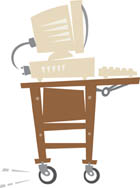
Simply put, the data is where the action is-the receiving dock, ingredient warehouse, production line, finished goods warehouse and other places. Because the data reflects what's going on in these areas, it drives maintenance, improves production operations, controls quality and improves inventory control.
Companies frequently attempt to collect data with paper forms. Initially, these forms work and appear to be low-cost, but they've often proved to be unreliable for both capturing all the requested data and the quality of that data. Why? Dock workers, forklift drivers and production personnel can find it difficult to work with paper forms. Their gloves get in the way. They don't have clean surfaces to work on. They're too busy doing their "real jobs" to record the data. And, even when they do record the data on paper forms, keying mistakes and/or misreading or misunderstanding the data can increase errors when the data's entered into systems.

The real-life pluses of mobile computing
A private label manufacturer of custom-formulated functional/medical food bars and powder supplements, Nellson Nutraceutical operates plants in Irwindale, CA, Salt Lake City and Montreal. Marc Gottlieb, director of ERP systems at Nellson Nutraceutical, tells of a study Nellson did on the cost of paper forms. In this study, he estimated the labor cost of paper forms averaged $0.50 per transaction. On the plant floor or in the warehouse, a person had to fill in each form that was later keyed in by another person. Since Nellson Nutraceutical was doing 900 transactions a day times 30 days per month, the company spent $13,500 a month to collect information in the plants. In addition, Gottlieb states that quality issues and a lag of three days before transactions were reflected in Nellson's systems, leading to additional problems in locating materials, production scheduling, etc.Mark Skoog, vice president of marketing at Advanced Food Systems (www.afsi.com), claims automation typically improves data collection efficiency up to 20 percent, with accuracy often approaching 99.5 percent. "When recorded at the source, the data is timelier, its quality improves, the odds of it actually being collected go up, and the cost of data collection is lowered," Skoog explains.
Mobile computing allows transactions to be entered at the source. With it, forklifts, QA personnel, receivers, production workers, etc. are equipped with wireless, handheld devices that serve multiple purposes. For example, these devices can give information to employees, telling them what to pick and where to get it. Equipped with barcode or RFID scanners, employees can scan items, lot numbers and pallet license plates, as well as labels placed on slots or bins. The quantities, notes, reason codes, test results, etc. then can be entered on a keyboard. With a wireless connection, the data can be verified from the central system in real time, allowing corrections to be made instantly. In addition, the central system is updated in real time, eliminating the lag between a transaction and the system update.
Nellson Nutraceutical's Gottlieb says his mobile computing data collection project was a big success. As a result of the project and the subsequent introduction of mobile computing, the company has reduced its data collection labor costs to almost nothing, accuracy has increased, and the three-day lag time has been completely eliminated. "We could not get along without it [mobile computing]," states Gottlieb.